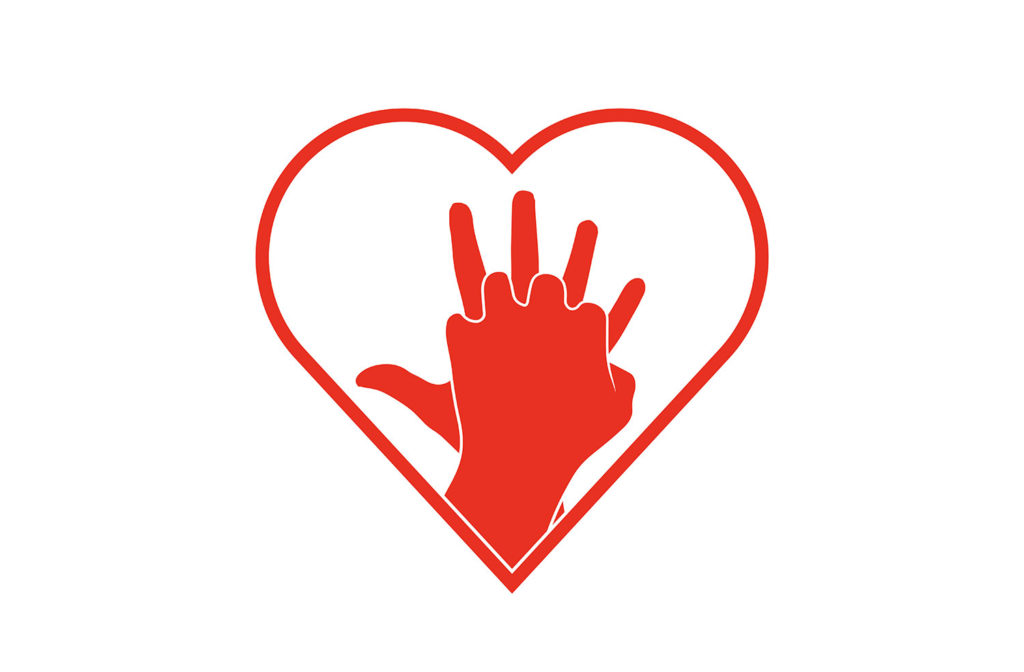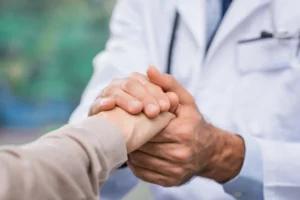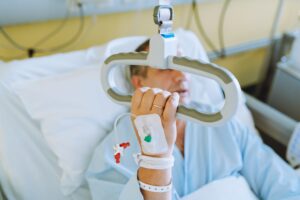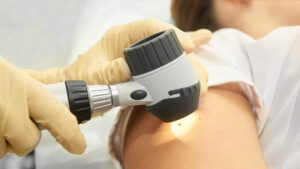Summary
Maimonides Director of Trauma and Acute Care Dr. Ronald Simon gives an overview on basics of emergency medical skills for average person. Be prepared for the next time a loved one gets in trouble!
Listen on Spotify Listen on Apple Podcasts Listen on Google Podcasts
Transcript
Prakash Chandran (Host): Many people live their lives without ever encountering a medical emergency situation that requires their assistance. There are, however, skills that every person should know should they encounter one that can help save lives. Here to tell us more is Dr. Ronald Simon, the Director of Trauma and Acute Care Surgery at Maimonides Medical Center. This is Maimo Med Talk. I’m your host. Prakash Chandran. So, Dr. Simon, thank you so much for joining me today. Really great to have you. You know, I wanted to get started by asking what are a few basic skills that the average person like myself can learn should they come across an emergency situation before professional medical help is available?
Ronald Simon, MD (Guest): Well, there, there are a couple of things that people should recognize where time is important. And I think as three global things are, would be, is somebody’s having a heart attack, is somebody’s having a stroke and has somebody injured themselves and they’re bleeding. And I think recognizing those diseases, because those are time important problems where what you do and how fast you act, can make a difference in how somebody does with those problems. So, recognizing a stroke, recognizing a heart attack and how to treat a patient, a person who may have put their hand through a windshield or a plate glass, or cut themselves, how do you manage simple problems like that, I think is very helpful.
“For a stroke, I know there’s that mnemonic BE FAST and B is for balance, E is for eyes, F is for face, A is for arms, S is for speech or slurring of the speech, and T is time because it’s time sensitive.”
Host: Yeah, absolutely. And putting aside the skills themselves, the first piece of this is really just being able to recognize some of the things that you just mentioned. Isn’t that correct?
Dr. Simon: Correct.
Host: And so, are there any best practices around recognizing some of these things, like, for example, for a stroke, I know there’s that mnemonic BE FAST and B is for balance, E is for eyes, F is for face, A is for arms, S is for speech or slurring of the speech, and T is time because it’s time sensitive. But what about recognizing a heart attack? I feel like those signs are a little less known.
Dr. Simon: Sure. The most common thing is chest pain and there are a lot of reasons people have chest pain and most people, no one wants to think that they’re having a heart attack. So, the first thing somebody goes is no it’s just indigestion or it must’ve been something that I ate, so they don’t want to take it seriously. But it is a serious problem. I’ll tell you that one of my friends called me – it had to probably be about a year ago and he called me and he said, you know, Ron I’m having some chest pain and it’s radiating down my arm. I haven’t had it before, but I think it was probably just the dinner that I ate and my response to him was I hope you don’t think that by you calling me on the phone with those symptoms that I’m going to tell you, no, don’t worry about it, you don’t have to go to the emergency department. I told them those are concerning signs. And I can’t help you over the phone and you need to go to the emergency department and get yourself checked out. And that time is important. So, I think that everyone needs to understand that chest pain while most often is not a serious problem. It can be a serious problem, and if you delay too long in getting it treated, then you may take away your ability to get certain treatments that are time-specific.
“If someone is having chest pain, it sounds like the best thing that you can do…(is) call 911 immediately.”
Host: Yeah. Understood. So, you know, that’s kind of, if someone is having chest pain, it sounds like the best thing that you can do for them is you’re on the phone, tell them to go to the emergency department. And if you’re with them, certainly call 911 immediately. But let’s talk about some of the actual, maybe tactical things that a person can do when they’re with someone that’s going through one of these things, you know, we’ve talked or we’ve seen you know, CPR done on the television before, even maybe something like the Heimlich maneuver in case someone is choking. Let’s I guess start with CPR. When would you perform something like CPR?
Dr. Simon: So CPR needs to be done correctly. And if you don’t do CPR correctly, you can end up doing more harm to a patient than helping them. CPR should be done on anybody who loses consciousness and you try and feel for a pulse, and if you can’t feel for a pulse and you don’t have a pulse, then you want to start doing CPR.
So, so I guess one of the most basic things are, feel on your own body, feeling your neck for where you can feel your carotid pulse or feel on your wrist, right below the crease of your wrist on the side of your thumb for what we call the radial pulse and see if you can feel a pulse, because if somebody falls down and they have a pulse, you don’t want to start doing CPR on them.
They may have just passed out because they were dehydrated, or for other reasons, some people just faint. So, you don’t want to start doing CPR on a person who just fainted. So, so you have to know how to feel for a pulse. And again, the best way to learn how to feel for a pulse is to feel it on yourself and maybe feel it on a family member or a loved one. If you really want to be able to do CPR correctly, you need to take a course. And the American Heart Association has a course that just takes a couple of hours to go through and they will teach you not only how to do CPR and when to do CPR, but it will also teach you the Heimlich maneuver and how to do the Heimlich maneuver. And taking simple course is actually very important because how you do it on an adult, a child and an infant are very different. And if you do it incorrectly, you can hurt the person. So, there, there are lots of little courses out there and we’ll talk about Stop the Bleed a little later in the segment. But there are some simple courses that you can take that don’t require a lot of reading. They don’t require a lot of learning. It’s just basically learning skills that can make the difference in whether or not you might be able to save up a person’s life or not.
Host: Okay. So what I’m hearing is the first thing you really need to learn is how to take a pulse properly to really recognize whether there is one before you perform CPR and for the CPR itself, this is not necessarily something we can describe accurately over this podcast, but it makes sense to go to the American Heart Association or another certified training center to learn how to do it. Is that correct?
Dr. Simon: That’s correct. And the other thing that goes along with the pulse is the person breathing? If somebody is not breathing and they’re blue, then they may have a pulse, but they are probably not going to have a pulse for a long period of time. So, you need to be able to assess and that’s pretty straightforward. Usually you can see if somebody’s breathing. Some people will take out a mirror and put it in front of somebody’s mouth and nose and see whether or not there’s condensation on that mirror. If you’re not breathing there won’t be any condensation. But if you have a person who’s not breathing and it doesn’t have a pulse, then CPR is the only thing that’s going to save that person.
But if they’re breathing and you’re not feeling a pulse, then you have to ask yourself, the difficult question is, do they have a pulse and I’m just not feeling it. Or is the breathing just a transient moment and in a little, in, in another 15 seconds, they’re not going to be breathing anymore. But these are all important things that will be taught to you in one of the American Heart Association Basic Life Support, BLS, Basic Life Support courses.
Host: Right. One of the other things that you mentioned was the Heimlich maneuver. Can you talk a little bit about when that is used, what it looks like, and if you can do anything else to aid a person who might be choking.
Dr. Simon: So choking is a very interesting thing. And, you know, we’ve all had experiences where we’ve seen somebody in a restaurant who was choking and it even happened to me one night when I was out, I was on call and I was running to the store to get my dinner. And then while I was there, the guy behind the counter who knew I was a doctor, doc go back quickly. There’s somebody in the restaurant who’s choking. And indeed somebody was choking on a piece of food. And I was able just with simple swift pats on the back or really slamming a person on the back, I was able to dislodge the food and the patient did fine, the person did fine so.
Recognizing that somebody’s choking, which is classically somebody wide eyed and point and holding their neck saying I can’t breathe. I can’t breathe. I can’t breathe. And in, in those circumstances they probably inhaled something into their windpipe and not down their esophagus. And you can try just, you know, slapping them very hard in the middle of their back between the shoulder blades and seeing if you just can’t dislodge it.
If that doesn’t work. And after a couple of tries, then you lie the patient down on the floor and you can actually, I’m sorry you put your arms around the patient. If they’re on the floor, it’s different. But before they go onto the floor and they’re standing with their, you know, saying I’m choking is you basically put your fist right below their rib cage in the middle, below where the bone ends and you just use two hands and you kind of thrust your hands up towards their heart. And hopefully that creates enough pressure in their chest to pop that piece of food out of their airway. And it’s, very classic that all of a sudden, if you do that and you do that, right, and it’s the right situation that you, that they will just kind of all of a sudden cough up this piece of food and that solves the problem. You have a new friend after you’ve accomplished that.
Host: Yeah, absolutely. And any high-level best practices if they are on the floor.
Dr. Simon: Well, then you basically straddle their pelvis. You kind of sit on top of their pelvis, put your two hands in that same area, right below their rib cage and a couple of quick pushes up towards kind of towards their upper back again, trying to increase the pressure in their chest, such that they pop the food out.
Host: So, I want to talk about more severe incidents that a person might encounter. You know, I’ve heard about the Stop the Bleed program, which basically teaches people skills on how to stop bleeding of a serious injury before a medical professional gets there. Right. So maybe you can speak to this program a little bit and what it trains people on.
Dr. Simon: So, this is also a one day, it’s probably a half a day program, just a couple of hours where we sit with you in the classroom, in a group setting. And we talk a little bit about, what’s go, what’s going on? How you have, what kind of injuries create the bleeding and some very simple steps that you can use to stop bleeding.
And sometimes it’s very simple where if somebody cut their wrist or again, the more common thing is somebody was closing a window and they pushed on the plane of glass, or they got pushed into a plane of glass and they cut their wrist or their arm, and there’s bleeding. The first thing that you can really do that may be all that you need to do is get a piece of cloth and put pressure on the wound.
And if you can stop the bleeding by simply putting a piece of cloth over the wound and pressing down on it, then you’ve done all you need to do. And you just keep doing that until help arrives. But sometimes the wounds are too big or it may be a car accident or an accident in a train station or God forbid a bombing or something along those lines where there’s no way that you can just put pressure on a wound.
And in those circumstances, you want to think about putting tourniquet above the injury. And that’s also a relatively straightforward thing that can be done within a few seconds that may save a life. And one of the things, when, you know, during the Boston bombing, there were a group of people that had bad injuries and bystanders put ties on, belts on these people, and we’re able to stop people from bleeding to death until the EMS providers arrived. So, it’s something relatively simple, like, as I said, like a tie or a belt where you put it around the limb, above the injury, maybe four or five inches above the injury. And then you just tighten it down as much as you can, until you see the bleeding stop.
When emergency medical services get there, they have special devices called true tourniquets, medical tourniquets that they can put on that are a little bit more sophisticated, but they do the same thing. They just create so much pressure on an area that it cuts off the blood flow and stops the bleeding from the injury.
Host: Yeah. That is a really helpful explanation. But if I’m understanding you correctly, the most important thing that people can do, if they want to learn the dynamics of how they can help people, if they come across these more severe situations is they should take the Stop the Bleed Program. And that is training from the American College of Surgeons. Is that correct?
Dr. Simon: Yeah. And I’ve taught the course multiple times. It’s very easy. And one of the beauties of the courses, even though you practice the skills on mannequins, just practicing it on a mannequin, sometimes the people have a difficult time with the whole concept or putting on a tourniquet or putting pressure on something that’s bleeding, but the simple act of doing it on a mannequin, gives them the confidence that they can do it on a real person. So, there’s really lot to be said for going and taking one of these Stop the Bleed courses that are offered around the country.
Host: Okay, perfect. I guess this is related, but let’s say someone comes across a situation where there is a detached limb, even something as small as a finger. Are there best practices that you can share around how one might preserve that limb to ensure its best chance of being reattached?
Dr. Simon: Well, it’s a fascinating question. I’ll tell you most people would walk upon the scene when a limb is severed, would just freeze in their tracks. And I would say that I know medical professionals when they come upon a scene like that also, you know, stop in their tracks. So you shouldn’t be surprised or dissuaded from doing anything just because you have a momentary pause, but, there’s not much that you can do to the actual limb that’s been severed other than keep it out of harm’s way from further damage. But what you really want to focus on is keeping the patient who just lost that limb, alive. And it’s all about stopping the bleeding. I would leave what any part of the limb that may be removed from the patient, I would just leave that alone and concentrate on saving the patient’s life. And when the EMS gets there, you can point out and say, listen, you know, over there, you know, a few feet away is the rest of his limb. Just, I just want you to be aware so you can bring it with the patient to the hospital, but I really wouldn’t focus on what the patient has lost, because what you want to do is you want to prevent the person from losing their life.
Host: So, just before we close, there are so many ways that a person might be able to help someone that they come across that is injured. We’ve talked about the Stop the Bleed Program, CPR. But what about just more basic things like applying a splint, right? Are there other things or skills that people need to learn in order to help someone that they come across that might need help?
Dr. Simon: Boy, I’ll tell you if it’s not as severe, and you’re thinking about putting a splint on a patient, I would probably argue, just leave the person alone until EMS gets there cause you, you don’t know that you might do more damage moving a broken limb, trying to put a splint on then the injury itself did. So all a bystander needs to do is stop a patient from dying. If somebody just has a broken arm or a limb, but they’re upset and or they’re panicking or something like that, rather than worrying about the limb, I would just try and calm the person down, let them know that they’re not alone. Let them know that you’re going to stay there with them until help arrives and that you’ve called for help and that they’re coming and that they’re going to be okay. And that’s the best thing to do if they don’t have a life-threatening injury.
Host: Yeah. So, if I could just summarize, a lot of the things that I’ve learned from you today, the first thing is really around recognition. You know, recognizing what you’re looking at. And if someone is experiencing something like a heart attack or they’re choking, or they’re having a stroke, really understanding the signs to look out for.
The second thing is kind of that assessment, like how do you take a pulse, right? Whether it’d be on your neck or your wrist, like learn how to do that. And then in terms of action, it’s really those courses with Stop the Bleed or the American Heart Association, which will teach you CPR, Heimlich maneuver, and the Stop the Bleed is kind of a, how to do like a tourniquet and really stop the bleeding until a medical professional can arrive. Is that a pretty good summary of what we’ve discussed?
Dr. Simon: I think it’s great. Again, if the patient is not trying, if the person is not trying to die in front of you, then just support the person. If they’re having a stroke, a heart attack or anything like that, if you’re not doing CPR or a Heimlich maneuver again, get help. Don’t waste time trying to do something that you may not be trained to do. Call for help as soon as possible, and then do what you can to help the patient.
Host: Well, Dr. Simon, thank you so much for this advice today and this information. Really appreciate your time.
Dr. Simon: It’s been my pleasure.
Host: That was Dr. Ronald Simon, the Director of Trauma and Acute Care Surgery at Maimonides. To attend some of the courses we discussed today, you can go to stopthebleed.org or for a course on CPR or the Heimlich maneuver, you can go to heart.org. To learn more about this topic, please visit maimo.org. That’s M A I M O.org, or call 718-283-7071 to make an appointment. This has been Maimo Med talk. I’m your host Prakash Chandran. Stay well.







